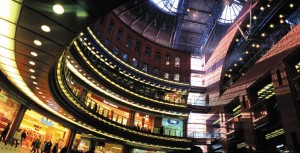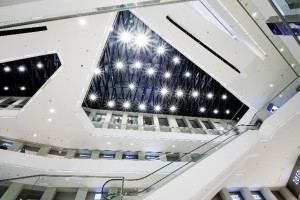By Dieter Bullinger
With regard to shopping centers, the terms recycling, redevelopment, revitalization, refurbishment, restructuring, relaunch, and repairs are often used indiscriminately (or even as synonyms) to characterize different forms of (structural) improvement of existing properties.
A new guide by gif (Gesellschaft für Immobilienwirtschaftliche Forschung/Society of Property Researchers Germany) entitled “Redevelopment—Guidelines for Handling Pre-Used Land and Buildings” (published in January 2016 and available free at www.gif-ev.de/onlineshop/detail/302) provides definitions of the various terms, calls attention to particular traps when it comes to “refurbishment,” and provides a checklist for the redevelopment process.
(Area) recycling and conversion
Area recycling and area reactivation refer to the reclamation of derelict land from large former industrial and commercial enterprises or infrastructure objects (e.g. freight rail). They usually consist of large areas and lots of lands. Such urban development projects are usually carried out in several stages, with the first development steps often initiated by public urban planning authorities.
Examples of large-area brownfield recycling include the development of the around 90 hectares of a former freight rail depot near Frankfurt’s convention center (Messe) into the new “European Quarter.” An even bigger example is HafenCity Hamburg on 240 hectares of former port and terminal areas.
The term “conversion” refers to a special type of land recycling used mainly for the conversion of former military sites. An example of a conversion is the new use of parts of the former military airfield in Zweibrücken, Germany, as an outlet center. The dividing lines between land recycling and redevelopments are often blurred.
Redevelopment
In the US, the term redevelopment is generally used to refer to reviving neighborhoods that are completely derelict or marked by massive vacancies. They usually also involve public funds to revive once-used but currently vacant land and buildings (partially by demolition and reconstruction) and provide new infrastructure and uses. In Europe, the term “area recycling” is more common for such operations because the term redevelopment in the US largely reflects urban and district-related characteristics and a “community action” aspect which are generally absent in the German-speaking world.
In German-speaking countries, definitions prevail that relate to individual properties and existing buildings that have been used previously or are (at least partially) still in use. It’s about individual (mostly private) investment in these properties to upgrade and expand or alter the use of the existing stock of land and buildings. The goal is to maintain existing buildings and sites and adapt them to new user requirements while preventing the decay of building fabrics and real estate values.
Experience from real estate project development, which arises out of the construction and use of hitherto unused areas, is often not 100% transferable to such cases. Instead, they require a broadening and deepening of the proven standards and procedures for real estate project development for new builds and additional consideration of specific redevelopment circumstances.
Unlike a revitalization, redevelopments regularly require a change in usage category (residential use on a former industrial site, theater in a former factory hall etc.). A trigger for redevelopments (and similarly for refurbishments and revitalizations) is the clearly looming threat to the economic and technical efficiency of the property due to its life cycle and the realization that (comprehensive) planning and building measures are required to achieve the property’s economic potential and improve its ability to recover.
It refers to land and buildings that already do not, or in the near future no longer can, fulfill their original purpose. In other words, their previous usage is largely or completely inappropriate and they must be given new uses via conversion of the existing building or demolition and reconstruction. The aim is structural to transform the buildings for new uses and thus appreciate the existing stock of land (and building fabric), achieving a new economic utilization of the real estate.
To create marketable new real estate requires either demolishing obsolete, disused buildings and replacing them with new buildings for other uses, or preserving disused buildings or ones close to being vacant by investing in the existing objects. Since redevelopments are associated with discontinuing the previous use, they are usually more comprehensive than revitalizations or refurbishments.

An example of a redevelopment of a larger area that replaced existing buildings is the shopping center Centro on a part of the 143-hectare site of a former steel and engineering company in the German city of Oberhausen. The situation is similar at shopping centers (some with additional uses such as hotels, museums, offices, etc.) on other former industrial sites that retained a significant portion of the existing buildings, like that on the site of a former textile

factory in Lodz—Manufaktura—or a former brewery in Poznan—Stary Browar. Further examples of redevelopments that at least partially preserved earlier buildings are the multifunctional project with a shopping center on the site of a former gasworks in Vienna—Gasometer—a former textile dyeing mill in Basel—Stücki—and a former paper mill in Zurich—Sihlcity.
Examples for redevelopments of smaller areas (that replaced existing buildings) include the construction of a shopping center on the site of a former slaughterhouse in Bayreuth—Rotmain Center—a former shoe factory in Klagenfurt—City-Arkaden—and a former brewery in Vienna—Riverside Liesing (with a number of apartments).
Smaller, but very interesting redevelopments include a bookstore’s use of a former church in Maastricht or two hotels’ use of former prisons in Basel and in the Danish city of Ribe. In many cases, cultural uses have moved into former commercial and industrial buildings, as with a theater in a former shipbuilding hall in Zurich or a museum in a former chocolate factory in Cologne. Such examples could continue almost indefinitely.
Revitalization

Revitalizations are (sometimes very comprehensive) structural adjustments to the quality and functionality of existing properties to adapt them (e.g. through technical, functional, and/or aesthetic aspects) to new user requirements. They take place when the current usage is maintained in principle, but the economic and technical life of the building is at or nearing its “use-by-date” and vacancy rates are already climbing or threaten to do so soon unless major investment measures are taken. This means that, as far as the property’s market acceptance goes, alarm bells have already begun ringing and a rapid descent into economic agony can no longer be ruled out.
The cause is usually that the property is aging and falling behind in competition with more recent offerings, resulting in a fall in the owners’ cash flow. The aim is to reposition the object and improve or restore the profitability, market importance, and marketability of buildings that are vacant or at risk of acute vacancy and that, in their current form, can be rented either not at all or only with difficulty. This is done through fundamental technical, structural, functional, and/or architectural measures. The measures may extend to a demolition and new build at the same location with the same use. They aim to improve the internal and external appearance of the property and to reposition the object in the market and therefore raise its value.
Examples of revitalizations include a series of remodelings of former department stores in various cities in Germany. Their previous usage “retail” was maintained, albeit sometimes in a heavily modified form. Examples include a Horten store in Krefeld, Germany, which is now Ostwall Carree after a renovation; a former Hertie store in Cuxhaven is now Nordsee-Galerie after a demolition and reconstruction; or two former Karstadt locations in Hamburg, which are now Kaufland hypermarkets after conversions. Another example is Kaufhaus Tyrol in the center of Innsbruck.
Refurbishment
A refurbishment is any improvement and enhancement of an existing building with the aim of adapting the current state of the building facilities and its overall quality to the desired target state with the same usage. This need usually arises from the new technical and aesthetic-visual and functional standards set by newer properties. It is about maintaining the usability of property in accordance with the current state of technology and market requirements so that it remains fully let at good conditions.
Refurbishments, therefore, include different measures of varying elaborateness to improve and enhance the still-functioning (i.e. not yet marked by vacancies or with only limited ones), but often outmoded property. The goal is to avoid the property falling behind (with an impact on occupancy rates) in the competition with similar properties. The term refurbishment, therefore, covers a wide range of measures of varying intensity. These include inspection, maintenance, repair, and modernization.
Refurbishments are often carried out with small-scale “beautifying” measures that are required on almost all properties from time to time in the form of “cosmetic repairs.” Comprehensive modernizations can also involve profound and costly interventions in properties as they mostly remain occupied in order to extend or adapt them to current requirements. Such extensive refurbishments are often called restructurings, relaunches, or renovations.
Most of the comprehensive modernizations of older, but still (almost) fully let shopping centers undertaken because their age, setup, or appearance no longer meet the customers’ current expectations are closer to refurbishments of (still basically “healthy”) objects than revitalizations of objects already marked by potentially lethal vacancies.
Examples of larger modernizations/refurbishments include the ongoing stages of modernization of the Glatt shopping center in Zurich and the recent comprehensive modernization of the now 40-year-old shopping center in Regensdorf near Zurich. The extensive modernization of the then 20-year-old shopping center Galleria in Vienna carried out in 2010 is also an example, as is the current conversion of the 40-year-old Huma shopping center in Vienna, which basically involved demolishing and re-building it.
For economic reasons, owners try as far as possible to combine a refurbishment with an extension/enlargement of the existing area, as was done recently at the Fischapark shopping center in Wiener Neustadt or with a similar object, Atrio in Villach, a few years ago. Similar economic considerations are behind attempts to connect the refurbishment of an existing building with an extension to new uses, such as when Vienna’s Westbahnhof was integrated with a shopping center, hotel, and extensive office space. A similar insertion of a shopping center took place in the ‘90s in Leipzig’s Main Station.
Almost any of the above-mentioned examples could tell an exciting story of its own about the specific challenges that arise in such projects and the special demands they make on the qualifications of the participants.





